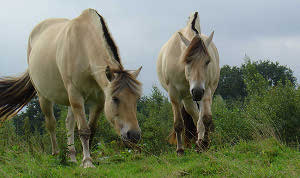 I’m slowly working my way through the colors section to give it a bit of an update. It was time for some new information and images – so I hope everyone likes it.
I’m slowly working my way through the colors section to give it a bit of an update. It was time for some new information and images – so I hope everyone likes it.
Dilutions
There is a wide variety of dilution genes which affect the two base colors as well as those affected by modifiers and white patterns. Today I want to share a little about the dun dilution which is incredibly common and often thought to be the toughest due to its obviously ancient origins.
Dun Dilution
The dun dilution has an effect on black, chestnut and bay bases and fairly easy to spot physically. This gene is clearly old as most ancestral horses were dun as are the last existing wild horses today.

Primitive Marking Terminology
Although they can be mistaken for buckskins, roans or even appaloosas, a dun animal is fairly easy to spot. They always display at least one of the primitive markings to some degree.
Dorsal Stripe – All dun animals have a dorsal stripe – it is the one marking that distinguishes them. It runs from the poll to the dock of the tail and is always darker than the coat color.
Zebra Striping – Also called leg barring, zebra striping is horizontal striping or barring on the legs – generally around the knees or hocks.
Shoulder Stripe – Also called shoulder shadow or shoulder webbing, this manifests itself in shading or striping coming off the dorsal and running down the withers.
Mottling – Also called webbing, cobwebbing and spiderwebbing and shows as mottling, striping or shading on the face, shoulder, hindquarters or ribs.
Face Mask – Dark shading on the face that ranges from a small patch of dark to an entirely black face.
Sandwich Mane – Also called frosting, the dorsal stripe creates a dark stripe in lighter manes, creating a sandwich effect.

Dun Colors
The dun dilution affects both base colors as well as those affected by other dilutions, modifiers or white patterns. A yellow dun, the most classic of duns is caused by dun on a bay base, creating a yellow colored animal with dark points. Dun on a chestnut base creates a red dun, with a lighter red coat and dark red points. Dun on a bay causes a smoky blue to slate grey animal with black points and dun on a seal brown creates a sort of muddy brown with dark points.
This dilution dictates that the mane, tail, points and primitive markings will always be darker than the coat color.
Learn More About Color
Be sure to visit the new and improved color section for more information about dun horses and stay tuned, next week we’ll continue the dilution genes by looking at the champagne dilution gene which creates coats that glow.
